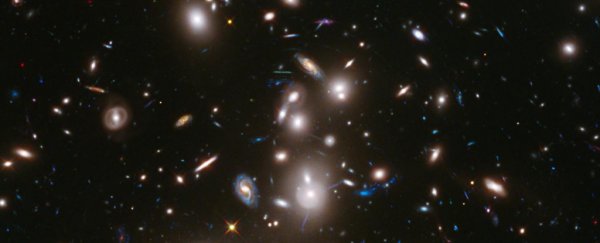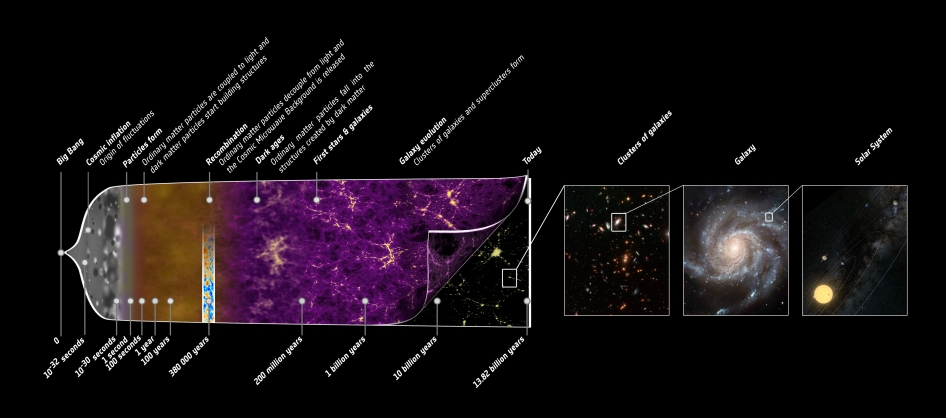At the outer reaches of the known Universe, entire galaxies - and all of the stars, planets, and alien species they may contain - are disappearing.
Of course, these objects aren't simply evaporating. They are being thrust out of the known Universe, forced into a mysterious expanse known as the "unobservable Universe."
However, in order to truly understand this fascinating sector of the cosmos, it's necessary to first understand two of the most startling scientific discoveries ever made.
An age-old question
For millennia, humans have been confounded by the size and age of the Universe. Does the cosmos go on forever, or does it have some kind of edge? Has it always existed, or did some event cause it to spring into being?
In 1687, Isaac Newton inspired a new way of understanding the cosmos in his book Principia, which proposed the revolutionary universal law of gravitation.
In its most basic formulation, the law explained that every mass in the Universe is attracted to every other mass in the Universe. While the idea seems simple enough, at the time the implications were staggering.
Newton's work revealed that, if our Universe was finite, the attractive forces of all of the objects in the cosmos should have caused everything to collapse back in on itself. Since that has not happened, logically it meant that the Universe must be infinite.
But because of something known as Olbers' paradox, scientists knew that this couldn't be the whole story. Most famously articulated by Wilhelm Olbers in the early 19th century, this paradox argues that the darkness found in the night sky conflicts with the conclusion that the cosmos is infinite.
We know that the apparent size of a star decreases as one's distance from it increases. But even though distant stars are smaller and dimmer, we'd see more of them - in a timeless sky without limits, we should still see nothing but starlight.
Since there are dark patches in the night sky, the Universe cannot be infinite.
So, Newton's and Olbers's ideas could not be reconciled. But in 1913, American astronomer Vesto Slipher analysed the spectral lines of distant galaxies and found that the light they emitted was shifted toward the red end of the light spectrum - and things began to change.
Slipher took this redshift as evidence that the galaxies are moving away from us, since light stretches towards the red end of the spectrum when objects are receding.
Building on Slipher's work, Edwin Hubble measured the galaxies' redshifts and then compared them with their relative distance, and he made a monumental discovery: the Universe is expanding.
Once you know that, you can infer that the Universe must have been smaller in the past, and subsequently, if you go far enough back in time, the entire Universe would have been converged into a single point. This point, which we now call the Big Bang, was the beginning of the Universe.
Using various models and estimates for the expansion rate, such as Hubble's constant, scientists estimated the age of the Universe. Today, that figure is 13.799 billion years (give or take 21 million).
So, nearly 9,000 years after the first civilisations began to form, we finally have a good grasp of the age of the Universe. Unfortunately, that expansion means we keep losing chunks of it.
Expanding horizons
In the closing decades of the 20th century, two teams of scientists set out to measure cosmic deceleration (how much the expansion of the Universe is slowing down).
For their work, they searched for Type 1a supernovae, measured their distances, and calculated the speed at which they are moving away from us. Remarkably, the teams discovered that, contrary to their assumptions, expansion is not slowing down.
Rather, the most distant galaxies appear to be flying away from us faster and faster as their distance from Earth increases.
This led to one irrefutable conclusion: the expansion of the Universe is accelerating.
Notably, it's not that the edges of the Universe are flying away from each other. Every portion of space is stretching. While light and matter has a maximum speed, the fabric of space-time itself doesn't. Volumes of the Universe can expand faster than light itself; the objects farthest from us are receding from us faster, as there is more space between us that's stretching.
New calculations, which take the accelerated expansion of the Universe into account, subsequently allowed us to determine that the observable Universe actually has a radius of at least 46 billion light-years.
The phrasing here is important, as the observable Universe is just a part of the total Universe. And this is where the unobservable Universe comes in.
Dark cosmos
The observable Universe is the spherical region that encompasses everything that can currently be detected from Earth. Everything that exists beyond the bounds of detection is said to be in the unobservable Universe - its light yet to arrive on Earth thanks to the vast distance it needs to cover.
Since light has a top speed, light from objects at a sufficient distance could theoretically still be on its way, yet to be seen.
Now, if the expansion of the Universe wasn't accelerating, given enough time, we'd eventually be able to see everything in the cosmos. But this isn't the case.
Because of accelerated expansion, regions of space that are sufficiently distant from Earth are moving away from us faster than the speed of light. This doesn't sound too alarming, until you stop and realise that light from these regions of the cosmos will never be able to reach us.
At the present juncture, if a photon left our planet and started to travel out into the cosmos, it would never be able to reach any area of space that's more than 15 billion light-years away, as space beyond this point is expanding faster than the speed of light.
Ultimately, this means that, even if we left today and were travelling at lightspeed, we'd only ever be able to reach a mere 3 percent of the total number of galaxies in our observable Universe. The other 97 percent are forever beyond our reach.
And because the expansion of the Universe is continuously accelerating, each year, more and more regions of space pass beyond our cosmic horizon and enter the unobservable Universe.
If that's not enough, this expansion has some rather bleak implications for the ultimate fate of the Universe. Assuming that expansion continues indefinitely, the horizon of the visible Universe will gradually shrink.
And over time, all the galaxies that aren't gravitationally bound to us - a small smattering about about 70 galaxies - will fade into the black abyss of the unobservable Universe. There's nothing we can do about it.
A version of this article was first published in December 2018.

